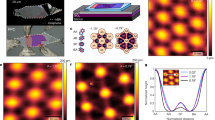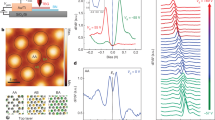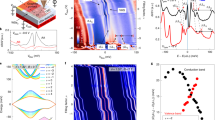Abstract
Two-dimensional atomic crystals can radically change their properties in response to external influences, such as substrate orientation or strain, forming materials with novel electronic structure1,2,3,4,5. An example is the creation of weakly dispersive, ‘flat’ bands in bilayer graphene for certain ‘magic’ angles of twist between the orientations of the two layers6. The quenched kinetic energy in these flat bands promotes electron–electron interactions and facilitates the emergence of strongly correlated phases, such as superconductivity and correlated insulators. However, the very accurate fine-tuning required to obtain the magic angle in twisted-bilayer graphene poses challenges to fabrication and scalability. Here we present an alternative route to creating flat bands that does not involve fine-tuning. Using scanning tunnelling microscopy and spectroscopy, together with numerical simulations, we demonstrate that graphene monolayers placed on an atomically flat substrate can be forced to undergo a buckling transition7,8,9, resulting in a periodically modulated pseudo-magnetic field10,11,12,13,14, which in turn creates a ‘post-graphene’ material with flat electronic bands. When we introduce the Fermi level into these flat bands using electrostatic doping, we observe a pseudogap-like depletion in the density of states, which signals the emergence of a correlated state15,16,17. This buckling of two-dimensional crystals offers a strategy for creating other superlattice systems and, in particular, for exploring interaction phenomena characteristic of flat bands.
This is a preview of subscription content, access via your institution
Access options
Access Nature and 54 other Nature Portfolio journals
Get Nature+, our best-value online-access subscription
$29.99 / 30 days
cancel any time
Subscribe to this journal
Receive 51 print issues and online access
$199.00 per year
only $3.90 per issue
Buy this article
- Purchase on Springer Link
- Instant access to full article PDF
Prices may be subject to local taxes which are calculated during checkout





Similar content being viewed by others
Data availability
The data that support the findings of this study are available from the corresponding authors on reasonable request.
References
Novoselov, K. S., Mishchenko, A., Carvalho, A. & Castro Neto, A. H. 2D materials and van der Waals heterostructures. Science 353, aac9439 (2016).
Li, G. et al. Observation of Van Hove singularities in twisted graphene layers. Nat. Phys. 6, 109–113 (2010).
Luican, A. et al. Single-layer behavior and its breakdown in twisted graphene layers. Phys. Rev. Lett. 106, 126802 (2011).
Cao, Y. et al. Correlated insulator behaviour at half-filling in magic-angle graphene superlattices. Nature 556, 80–84 (2018).
Cao, Y. et al. Unconventional superconductivity in magic-angle graphene superlattices. Nature 556, 43–50 (2018).
Bistritzer, R. & MacDonald, A. H. Moiré bands in twisted double-layer graphene. Proc. Natl Acad. Sci. USA 108, 12233–12237 (2011).
Bao, W. et al. Controlled ripple texturing of suspended graphene and ultrathin graphite membranes. Nat. Nanotechnol. 4, 562–566 (2009).
Cai, S., Breid, D., Crosby, A. J., Suo, Z. & Hutchinson, J. W. Periodic patterns and energy states of buckled films on compliant substrates. J. Mech. Phys. Solids 59, 1094–1114 (2011).
Cerda, E. & Mahadevan, L. Geometry and physics of wrinkling. Phys. Rev. Lett. 90, 074302 (2003).
Guinea, F., Katsnelson, M. I. & Geim, A. K. Energy gaps and a zero-field quantum Hall effect in graphene by strain engineering. Nat. Phys. 6, 30–33 (2010).
Ramezani Masir, M., Moldovan, D. & Peeters, F. M. Pseudo magnetic field in strained graphene: Revisited. Solid State Commun. 175–176, 76–82 (2013).
Schneider, M., Faria, D., Kusminskiy, S. V. & Sandler, N. Local sublattice symmetry breaking for graphene with a centrosymmetric deformation. Phys. Rev. B. 91, 161407 (2015).
Amorim, B. et al. Novel effects of strains in graphene and other two dimensional materials. Phys. Rep. 617, 1–54 (2016).
Jiang, Y. et al. Visualizing strain-induced pseudomagnetic fields in graphene through an hBN magnifying glass. Nano Lett. 17, 2839–2843 (2017).
Kerelsky, A. et al. Maximized electron interactions at the magic angle in twisted bilayer graphene. Nature 572, 95–100 (2019).
Jiang, Y. et al. Charge order and broken rotational symmetry in magic-angle twisted bilayer graphene. Nature 573, 91–95 (2019).
Xie, Y. et al. Spectroscopic signatures of many-body correlations in magic-angle twisted bilayer graphene. Nature 572, 101–105 (2019).
Kopnin, N. B., Heikkilä, T. T. & Volovik, G. E. High-temperature surface superconductivity in topological flat-band systems. Phys. Rev. B 83, 220503 (2011).
Kauppila, V. J., Aikebaier, F. & Heikkilä, T. T. Flat-band superconductivity in strained Dirac materials. Phys. Rev. B 93, 214505 (2016).
Tang, E. & Fu, L. Strain-induced partially flat band, helical snake states and interface superconductivity in topological crystalline insulators. Nat. Phys. 10, 964–969 (2014).
Du, X., Skachko, I., Duerr, F., Luican, A. & Andrei, E. Y. Fractional quantum Hall effect and insulating phase of Dirac electrons in graphene. Nature 462, 192–195 (2009).
Bolotin, K. I., Ghahari, F., Shulman, M. D., Stormer, H. L. & Kim, P. Observation of the fractional quantum Hall effect in graphene. Nature 462, 196–199 (2009); erratum 475, 122 (2011).
Andrei, E. Y. et al. Observation of the magnetically induced Wigner solid. Phys. Rev. Lett. 60, 2765 (1988).
Levy, N. et al. Strain-induced pseudo-magnetic fields greater than 300 tesla in graphene nanobubbles. Science 329, 544–547 (2010).
Carrillo-Bastos, R. et al. Strained fold-assisted transport in graphene systems. Phys. Rev. B 94, 125422 (2016).
Giovannetti, G. et al. Doping graphene with metal contacts. Phys. Rev. Lett. 101, 026803 (2008).
Luican, A., Li, G. & Andrei, E. Y. Scanning tunneling microscopy and spectroscopy of graphene layers on graphite. Solid State Commun. 149, 1151–1156 (2009).
Moldovan, D., Masir, M. R. & Peeters, F. M. Electronic states in a graphene flake strained by a Gaussian bump. Phys. Rev. B 88, 035446 (2013).
Neek-Amal, M., Covaci, L., Shakouri, K. & Peeters, F. M. Electronic structure of a hexagonal graphene flake subjected to triaxial stress. Phys. Rev. B 88, 115428 (2013).
Gomes, K. K., Mar, W., Ko, W., Guinea, F. & Manoharan, H. C. Designer Dirac fermions and topological phases in molecular graphene. Nature 483, 306–310 (2012).
Settnes, M., Power, S. R. & Jauho, A. P. Pseudomagnetic fields and triaxial strain in graphene. Phys. Rev. B 93, 035456 (2016).
Georgi, A. et al. Tuning the pseudospin polarization of graphene by a pseudomagnetic field. Nano Lett. 17, 2240–2245 (2017).
Zhang, Z. Z., Chang, K. & Peeters, F. M. Tuning of energy levels and optical properties of graphene quantum dots. Phys. Rev. B 77, 235411 (2008).
Palacios-Berraquero, C. et al. Large-scale quantum-emitter arrays in atomically thin semiconductors. Nat. Commun. 8, 15093 (2017).
Milovanović, S. P., Anđelković, M., Covaci, L. & Peeters, F. M. Periodically strained graphene lattice: flat bands. Preprint at http://arXiv.org/abs/1910.11752 (2019).
Li, G., Luican, A. & Andrei, E. Y. Self-navigation of a scanning tunneling microscope tip toward a micron-sized graphene sample. Rev. Sci. Instrum. 82, 073701 (2011).
Yankowitz, M. et al. Emergence of superlattice Dirac points in graphene on hexagonal boron nitride. Nat. Phys. 8, 382–386 (2012).
Andrei, E. Y., Li, G. H. & Du, X. Electronic properties of graphene: a perspective from scanning tunneling microscopy and magnetotransport. Rep. Prog. Phys. 75, 056501 (2012).
Anđelković, M., Covaci, L. & Peeters, F. M. DC conductivity of twisted bilayer graphene: angle-dependent transport properties and effects of disorder. Phys. Rev. Mater. 2, 034004 (2018).
Weiße, A., Wellein, G., Alvermann, A. & Fehske, H. The kernel polynomial method. Rev. Mod. Phys. 78, 275–306 (2006).
Acknowledgements
We acknowledge support from the DOE (DOE-FG02-99ER45742; E.Y.A., Y.J.), the Gordon and Betty Moore Foundation (GBMF9453; E.Y.A.), the National Key R&D Program of China (2019YFA0307800, 2018YFA0305800; J.M.), the Beijing Natural Science Foundation (Z190011; J.M.), the Flemish Science Foundation (FWO-Vl; S.P.M. and F.M.P.), and the TRANS2DTMD Flag-Era project (M.A., L.C. and F.M.P.). We thank F. Guinea, B. Davidovitch and D. Vella for stimulating discussions during the Aspen winter workshop on low-dimensional solids in hard and soft condensed matter.
Author information
Authors and Affiliations
Contributions
J.M. and Y.J. performed STM/STS measurements. Y.J., J.M. and E.Y.A. designed the research strategy, performed data analysis and wrote the manuscript with input from all authors. S.P.M., M.A., L.C. and F.M.P. performed theoretical calculations. Y.C., A.K.G. and X.L. fabricated the devices. K.W. and T.T. provided hBN. E.Y.A. supervised the project.
Corresponding authors
Ethics declarations
Competing interests
The authors declare no competing interests.
Additional information
Peer review information Nature thanks Dante Kennes and the other, anonymous, reviewer(s) for their contribution to the peer review of this work.
Publisher’s note Springer Nature remains neutral with regard to jurisdictional claims in published maps and institutional affiliations.
Extended data figures and tables
Extended Data Fig. 1 Buckling pattern of graphene.
a, Large-area STM topography of G/NbSe2 shows two ridges that delimit the buckling pattern (Vb = −0.3 V, I = 20 pA). b, Schematic of wrinkles arising from the compressive strain at each boundary ridge. Crests form at the wrinkle intersections, marked by black dots. c, Zoomed-in topography image of the triangular buckling pattern (Vb = 0.5 V, I = 20 pA) in a. d, The superlattice constant, measured along the line marked by the blue arrow in c, increases monotonically with distance from the apex where the two ridges meet. e, Height profile along the green arrow in a. f, Strain produced by the collapse of the ridges calculated from e, as described in Methods section ‘Buckling pattern formation’.
Extended Data Fig. 2 Topography of unbuckled regions in the G/NbSe2 sample.
a, Main panel, STM topography of a flat (unbuckled) region of the G/NbSe2 surface far from the ridges. Inset, dI/dV spectrum from the region shown in the main panel (Vb = 0.5 V, I = 30 pA). b, Atomic-resolution view of G/NbSe2 in a (Vb = −0.3 V, I = 30 pA). c, Same as a but from a flat region of the G/hBN sample. Inset, dI/dV spectra of flat G/hBN for conditions of electron-doping (green trace) and hole-doping (red trace); Vb = −0.3 V, I = 20 pA.
Extended Data Fig. 3 Topography of buckled regions in the G/NbSe2 sample.
a, STM topography of a region in the buckled graphene membrane measured with different bias voltages: 500 mV (left) and 50 mV (right). b, dI/dV map over an area of size 6 nm × 6 nm in the crest region at the energy of the N = 0 PLL.
Extended Data Fig. 4 Transition area in the triangular buckling pattern of the G/NbSe2 sample.
a, Theoretical contour plot of the LDOS spectra connecting two crest areas (at x = 0 nm and x = 25 nm; see Fig. 3g, upper panel) versus energy, E, and position, x. The colour scale bar represents the LDOS intensity. The yellow dashed line labels the LDOS spectrum in the transition region plotted in b. b, Experimental dI/dV spectrum in the transition region between crests and troughs. Green and red arrows indicate the corresponding peaks in a.
Extended Data Fig. 5 Evolution of the calculated LDOS with PMF amplitude for several superlattice periods.
Shown are contour plots of the LDOS for several values of ab (left to right: 12 nm, 14 nm, 16 nm) in the crest region versus the amplitude of the magnetic field, B, and energy, E. Dashed lines represent the field dependence of the PLL energy in a uniform magnetic field given by the x-axis values.
Extended Data Fig. 6 Calculated PMF in the crest areas of the buckled G/NbSe2 sample.
a, LDOS cuts in the crest region from Fig. 3a, upper panel (A sublattice), for several values of B and corresponding Beff (first and second columns in the key). The ratio of the effective PMF obtained from the PLL spectrum on the crests to the maximum PMF value \(({B}_{{\rm{eff}}}/{B}_{{\rm{PMF}}}^{\max })\) is shown in the rightmost column of the key. b, Comparison of crest LDOS at Beff = 112 T for two lattice constants (14.0 nm and 14.8 nm) in the regime where the N = 0 peaks merge into one.
Extended Data Fig. 7 Calculated low-energy band structure and LDOS in the trough regions of the buckled G/NbSe2 sample.
a, b, Band structure (a) and LDOS (b) for a PMF of 140 T. c, d, As a but for a PMF of 180 T. Calculations are for a superlattice period of 14 nm.
Extended Data Fig. 8 Tight-binding model for a strained lattice.
a, Calculated profile of the PMF given by equation (1) for lattice spacing ab = 14 nm. b, Schematic of nearest neighbour vectors, δ1, δ2 and δ3, in a graphene lattice.
Extended Data Fig. 9 PMF for a rectangular buckling pattern in graphene.
a, Profile of the PMF in a rectangular buckling pattern. Dashed rectangle shows the magnetic unit cell. b, LDOS (sublattice averaged) versus the PMF amplitude B and energy E at a crest position in a (centre of red region marked by a green dot). The colour scale bar represents the LDOS intensity in arbitrary units. Note that the same result is obtained in the centre of troughs (blue regions) where the PMF sign is reversed. c, As b but for a point with zero field, marked in a by the magenta square. d, Contour plot of the LDOS versus energy and superlattice spacing shows the evolution of the confinement levels with unit cell size. The colour scale bar represents the LDOS intensity. e, Cut of the LDOS from b for a constant value of the field, B = 62 T, shown by the dashed white line. f, Cut of the LDOS from c for a constant value of the field, B = 62 T, shown by the dashed white line. g, Fitting the peak sequence to a square-root dependence on the PLL index gives an effective PMF of 100 T. h, The peak sequence in f gives a linear dependence on the peak index with an energy spacing of about 83 meV.
Extended Data Fig. 10 DOS versus unit cell size in the presence of lattice disorder.
a–d, The PMF profile used for calculating the DOS shown in e. The unit cell period variation range is given by (1 ± Δ)0 with a0 = 20 nm and Δ = 0 (a), 0.15 (b), 0.25 (c) and 0.33 (d). e, DOS obtained for different values of Δ given in the key for B = 62 T (as in Extended Data Fig. 9).
Rights and permissions
About this article
Cite this article
Mao, J., Milovanović, S.P., Anđelković, M. et al. Evidence of flat bands and correlated states in buckled graphene superlattices. Nature 584, 215–220 (2020). https://doi.org/10.1038/s41586-020-2567-3
Received:
Accepted:
Published:
Issue Date:
DOI: https://doi.org/10.1038/s41586-020-2567-3
This article is cited by
-
Twisted bilayer zigzag-graphene nanoribbon junctions with tunable edge states
Nature Communications (2023)
-
Imaging quantum oscillations and millitesla pseudomagnetic fields in graphene
Nature (2023)
-
High-throughput ab initio design of atomic interfaces using InterMatch
Nature Communications (2023)
-
Local control of superconductivity in a NbSe2/CrSBr van der Waals heterostructure
Nature Communications (2023)
-
Strong second-harmonic generation by sublattice polarization in non-uniformly strained monolayer graphene
Nature Communications (2023)
Comments
By submitting a comment you agree to abide by our Terms and Community Guidelines. If you find something abusive or that does not comply with our terms or guidelines please flag it as inappropriate.



